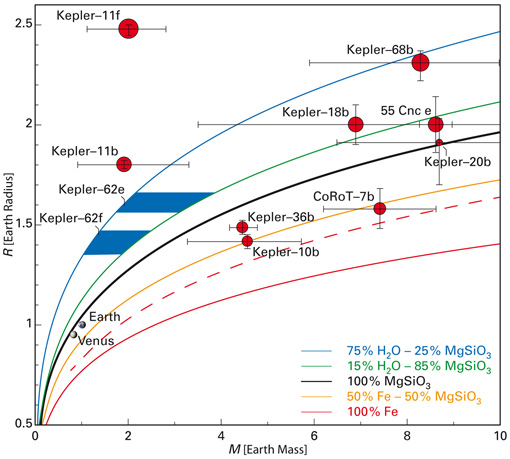This might be the most exciting exoplanet news yet. An international team of scientists analyzing data from NASA’s Kepler mission has found a planetary system with two small, potentially rocky planets that lie within the habitable zone of their star. The star, Kepler-62, is a bit smaller and cooler than our Sun, and is home to a five-planet system. Two of the worlds, Kepler-62e and Kepler-62f are the smallest exoplanets yet found in a habitable zone, and they might both be covered in water or ice, depending on what kind of atmosphere they might have.
“Imagine looking through a telescope to see another world with life just a few million miles from your own. Or, having the capability to travel between them on a regular basis. I can’t think of a more powerful motivation to become a space-faring society,” said Harvard astronomer Dimitar Sasselov, who is co-author of a new paper describing the discovery.

Masses and sizes for selected planets. The curves show the mass-radius-relation (average density) for different types of planets: The blue line indicates the loci of planets made mostly (75%) of water, the black line that of planets like our Earth that consist almost exclusively of rock (represented here by the mineral Enstatite, MgSiO3, a member of the pyroxite silicate mineral series that makes up most of the Earth’s mantle), and so on. The measured radii of Kepler-62e and Kepler-62f plus an estimate of their mass places them in a region (blue areas) where it is highly probable for them to be earth-like planets, that is: planets with a solid (if possibly covered in water) surface. Kepler-11f, on the other hand, is a Mini-Neptune, showing clearly that a comparatively low mass does not necessarily make for a solid planet. Image: L. Kaltenegger (MPIA)

The habitable zone (in which liquid water on a planet’s surface can exist) for different types of stars. The inner planets of our Solar System are shown on top, with Earth and Mars in the habitable zone. Kepler-62 is a notably cooler star, and Kepler-62e and -62f are in its habitable zone. For Kepler-69c, another planet announced today by NASA, the error bars for the star’s radiation are such that it could possibly in the habitable zone as well. Kepler-22b, the smallest planet found in a habitable zone before the recent discoveries, is very likely a Mini-Neptune, and not a solid planet. In what is denoted the empirical habitable zone, liquid water can exist on the surface of a planet if that planet has sufficient cloud cover. In the narrow habitable zone, liquid water can exist on the surface even without the presence of a cloud cover. Image: L. Kaltenegger (MPIA)
Youtube NASA here: Kepler-62 in the constellation Lyra, and is about 1,200 light-years from Earth.
Read more: http://www.universetoday.com/101489...-potentially-habitable-planets/#ixzz2QwwMj8Hm
Simply put ... damn cool! Dev's, hope your watching this.
“Imagine looking through a telescope to see another world with life just a few million miles from your own. Or, having the capability to travel between them on a regular basis. I can’t think of a more powerful motivation to become a space-faring society,” said Harvard astronomer Dimitar Sasselov, who is co-author of a new paper describing the discovery.

Masses and sizes for selected planets. The curves show the mass-radius-relation (average density) for different types of planets: The blue line indicates the loci of planets made mostly (75%) of water, the black line that of planets like our Earth that consist almost exclusively of rock (represented here by the mineral Enstatite, MgSiO3, a member of the pyroxite silicate mineral series that makes up most of the Earth’s mantle), and so on. The measured radii of Kepler-62e and Kepler-62f plus an estimate of their mass places them in a region (blue areas) where it is highly probable for them to be earth-like planets, that is: planets with a solid (if possibly covered in water) surface. Kepler-11f, on the other hand, is a Mini-Neptune, showing clearly that a comparatively low mass does not necessarily make for a solid planet. Image: L. Kaltenegger (MPIA)

The habitable zone (in which liquid water on a planet’s surface can exist) for different types of stars. The inner planets of our Solar System are shown on top, with Earth and Mars in the habitable zone. Kepler-62 is a notably cooler star, and Kepler-62e and -62f are in its habitable zone. For Kepler-69c, another planet announced today by NASA, the error bars for the star’s radiation are such that it could possibly in the habitable zone as well. Kepler-22b, the smallest planet found in a habitable zone before the recent discoveries, is very likely a Mini-Neptune, and not a solid planet. In what is denoted the empirical habitable zone, liquid water can exist on the surface of a planet if that planet has sufficient cloud cover. In the narrow habitable zone, liquid water can exist on the surface even without the presence of a cloud cover. Image: L. Kaltenegger (MPIA)
Youtube NASA here: Kepler-62 in the constellation Lyra, and is about 1,200 light-years from Earth.
Read more: http://www.universetoday.com/101489...-potentially-habitable-planets/#ixzz2QwwMj8Hm
Simply put ... damn cool! Dev's, hope your watching this.


